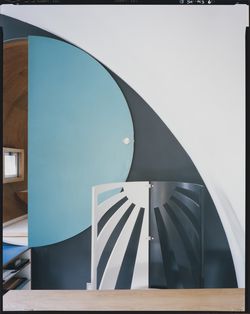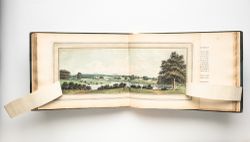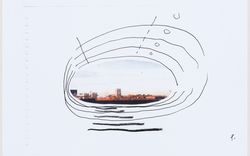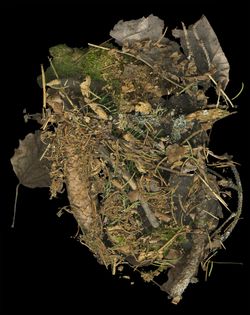archives
Level of archival description:
Collection
Kiran Mukerji Collection
CD038
Synopsis:
The Kiran Mukerji collection contains Kiran Mukerji’s research material on building and design technologies for affordable housing, which consists mostly of publications, and a few textual records the Institut für Tropenbau (Institute for Tropical Building).
1972-2013
Kiran Mukerji Collection
Actions:
CD038
Synopsis:
The Kiran Mukerji collection contains Kiran Mukerji’s research material on building and design technologies for affordable housing, which consists mostly of publications, and a few textual records the Institut für Tropenbau (Institute for Tropical Building).
archives
Level of archival description:
Collection
1972-2013
archives
Level of archival description:
Fonds
Peter Eisenman fonds
AP143
Synopsis:
The Peter Eisenman fonds documents Eisenman's professional activities as an architect, teacher, and author from the 1950s to 2008. More than 200 projects are represented through conceptual and design development drawings, models, photographs, textual records, and computer-aided drawings. Also well represented in the fonds are materials related to Eisenman's exhibitions, publications, and writings.
1925-2008, predominant 1951-2008
Peter Eisenman fonds
Actions:
AP143
Synopsis:
The Peter Eisenman fonds documents Eisenman's professional activities as an architect, teacher, and author from the 1950s to 2008. More than 200 projects are represented through conceptual and design development drawings, models, photographs, textual records, and computer-aided drawings. Also well represented in the fonds are materials related to Eisenman's exhibitions, publications, and writings.
archives
Level of archival description:
Fonds
1925-2008, predominant 1951-2008
archives
Level of archival description:
Fonds
Cedric Price fonds
AP144
Synopsis:
The Cedric Price fonds documents the personal activities and professional practice of architect Cedric Price, and includes his student work and architectural and urban planning projects. The fonds also contains records that document Cedric Price's teaching, publication, and exhibition activities. The archive comprises over 200 projects, from Price's student work in the 1950s at the University of Cambridge and the Architectural Association to projects he undertook as late as 2000. Key projects that are represented include New Aviary (1960-1966), Fun Palace (1961-1974), Potteries Thinkbelt (1963-1967), Inter-Action Centre (1971-1979), Generator (1976-1980), and Magnet (1995-1996).
1903-2006, predominant 1953-2000
Cedric Price fonds
Actions:
AP144
Synopsis:
The Cedric Price fonds documents the personal activities and professional practice of architect Cedric Price, and includes his student work and architectural and urban planning projects. The fonds also contains records that document Cedric Price's teaching, publication, and exhibition activities. The archive comprises over 200 projects, from Price's student work in the 1950s at the University of Cambridge and the Architectural Association to projects he undertook as late as 2000. Key projects that are represented include New Aviary (1960-1966), Fun Palace (1961-1974), Potteries Thinkbelt (1963-1967), Inter-Action Centre (1971-1979), Generator (1976-1980), and Magnet (1995-1996).
archives
Level of archival description:
Fonds
1903-2006, predominant 1953-2000
Kazuo Shinohara was a deeply influential figure in postwar architecture in Japan best known for his individual houses, but he remains little studied today, especially outside Japan. Shinohara connected traditional forms and an investigation of modernist tenets with the high-tech and information technology moments yet to come. What was his attitude toward history, and how(...)
Paul Desmarais Theatre Keyword(s):
David B. Stewart, Kazuo Shinohara, What is/was history for…
21 September 2017, 6:30pm
David B. Stewart, what was history for Kazuo Shinohara?
Actions:
Description:
Kazuo Shinohara was a deeply influential figure in postwar architecture in Japan best known for his individual houses, but he remains little studied today, especially outside Japan. Shinohara connected traditional forms and an investigation of modernist tenets with the high-tech and information technology moments yet to come. What was his attitude toward history, and how(...)
Paul Desmarais Theatre Keyword(s):
David B. Stewart, Kazuo Shinohara, What is/was history for…
Series
AP119.S1
Description:
The series contains drawings for Peter Yeadon's architectural narrative for the Prix de Rome entitled "Karl: An Architerctural Narrative." In total eleven sets of digital prints were made, each set contains eighteen sheets. Canadian Centre for Architecture received the third of these eleven sets, which is included in this series. The narrative depicts the experience of a Canadian emigrant becoming a Roman citizen. The drawings represent the following titles: City; Fabric House; Columbarium; Horizon House; House City; Depth House; Colosseum for Vanishing Curiosities; City Gate; Teatro de Tevere; Neptune House; Bath; and Bricolage House. Each drawing is signed by the architect. Also included, are four sketchbooks for 'Karl: An Architerctural Narrative', two print proofs for Bricolage House, and project documentation. The documentation explains each of the titles in the narrative, Yeadon's curriculum vitae, and leaflets for the exhibition "Karl: an architectural narrative" held at the Art Gallery of Windsor, Ontario from August 2001 to January 2002.
1998-2002
Karl: An Architectural Narrative (2000-2002)
Actions:
AP119.S1
Description:
The series contains drawings for Peter Yeadon's architectural narrative for the Prix de Rome entitled "Karl: An Architerctural Narrative." In total eleven sets of digital prints were made, each set contains eighteen sheets. Canadian Centre for Architecture received the third of these eleven sets, which is included in this series. The narrative depicts the experience of a Canadian emigrant becoming a Roman citizen. The drawings represent the following titles: City; Fabric House; Columbarium; Horizon House; House City; Depth House; Colosseum for Vanishing Curiosities; City Gate; Teatro de Tevere; Neptune House; Bath; and Bricolage House. Each drawing is signed by the architect. Also included, are four sketchbooks for 'Karl: An Architerctural Narrative', two print proofs for Bricolage House, and project documentation. The documentation explains each of the titles in the narrative, Yeadon's curriculum vitae, and leaflets for the exhibition "Karl: an architectural narrative" held at the Art Gallery of Windsor, Ontario from August 2001 to January 2002.
Series
1998-2002
archives
Level of archival description:
Fonds
AP170
Synopsis:
The Mark Goulthorpe HypoSurface project records, 1990-2014, document the design development, technical implementation, exhibition, and marketing of various iterations of the HypoSurface wall. The wall has a “skin” divided up into pixel-like metallic facets manipulated by a network of actuating pistons in order to create images, texts and patterns in dynamic relief. Sensors allow people near the wall to influence its movement. The records include approximately 62,700 digital files, 3 folders of textual documents, and 44 prototype pieces, and a working HypoSurface wall module.
1990 - 2014
Mark Goulthorpe Hyposurface project records
Actions:
AP170
Synopsis:
The Mark Goulthorpe HypoSurface project records, 1990-2014, document the design development, technical implementation, exhibition, and marketing of various iterations of the HypoSurface wall. The wall has a “skin” divided up into pixel-like metallic facets manipulated by a network of actuating pistons in order to create images, texts and patterns in dynamic relief. Sensors allow people near the wall to influence its movement. The records include approximately 62,700 digital files, 3 folders of textual documents, and 44 prototype pieces, and a working HypoSurface wall module.
archives
Level of archival description:
Fonds
1990 - 2014
Reading Landscapes
Reading Landscapes is a small selection of books from the CCA Collection that reflect on the ever-changing concept of landscape. The books on display bring together various landscape readings and highlight singular publishing techniques and formats, recognizing the gaps intrinsic to the history of publishing that are present in our library’s collection.
14 March 2024 to 2 March 2025
Reading Landscapes
Actions:
Description:
Reading Landscapes is a small selection of books from the CCA Collection that reflect on the ever-changing concept of landscape. The books on display bring together various landscape readings and highlight singular publishing techniques and formats, recognizing the gaps intrinsic to the history of publishing that are present in our library’s collection.
articles
A Lung for Midtown Manhattan
A Lung for Midtown Manhattan
Cedric Price's entry to the IFCCA Prize Competition for the Design of Cities, 1999
Actions:
The Dark Edge of a Clear-cut
In a conversation moderated by Louise Désy, CCA Curator, Photographs, Lorraine Gilbert presents her work: The documentation of landscapes I have lived and worked in has resulted in a body of work that questions our place within nature and within our built environments. The seemingly objective nature of the way I have pictured these natural and urban spaces, has given way(...)
Main galleries Keyword(s):
The Dark Edge of a Clear-cut, Canada, It's all happening so fast, conversation
4 February 2017, 3pm
The Dark Edge of a Clear-cut
Actions:
Description:
In a conversation moderated by Louise Désy, CCA Curator, Photographs, Lorraine Gilbert presents her work: The documentation of landscapes I have lived and worked in has resulted in a body of work that questions our place within nature and within our built environments. The seemingly objective nature of the way I have pictured these natural and urban spaces, has given way(...)
Main galleries Keyword(s):
The Dark Edge of a Clear-cut, Canada, It's all happening so fast, conversation
archives
Level of archival description:
Fonds
Van Ginkel Associates fonds
AP027
Synopsis:
The Van Ginkel Associates fonds is comprised of documents concerning van Ginkel Associates, van Ginkel Associates Ltd., Ecos Ltd., van Ginkel Partners, Ginkelvan Ltd, van Ginkel Associates Ltd. (1977), the styles under which H.P. van Ginkel and Blanche Lemco van Ginkel practiced as a multidisciplinary planning, management and architecture firm. Much of the van Ginkels' work was done in the Montréal area and nation-wide. The fonds contains approximately 1 985 drawings (1 420 originals plus 565 reproductions), 41 boards, 3 photographs, 2 collages, 2 typescripts, 1 model, 1 sketchbook and approximately 12.23 meters of textual documents. The documents were primarily produced between 1955 and 1980.
1944-1992
Van Ginkel Associates fonds
Actions:
AP027
Synopsis:
The Van Ginkel Associates fonds is comprised of documents concerning van Ginkel Associates, van Ginkel Associates Ltd., Ecos Ltd., van Ginkel Partners, Ginkelvan Ltd, van Ginkel Associates Ltd. (1977), the styles under which H.P. van Ginkel and Blanche Lemco van Ginkel practiced as a multidisciplinary planning, management and architecture firm. Much of the van Ginkels' work was done in the Montréal area and nation-wide. The fonds contains approximately 1 985 drawings (1 420 originals plus 565 reproductions), 41 boards, 3 photographs, 2 collages, 2 typescripts, 1 model, 1 sketchbook and approximately 12.23 meters of textual documents. The documents were primarily produced between 1955 and 1980.
archives
Level of archival description:
Fonds
1944-1992



